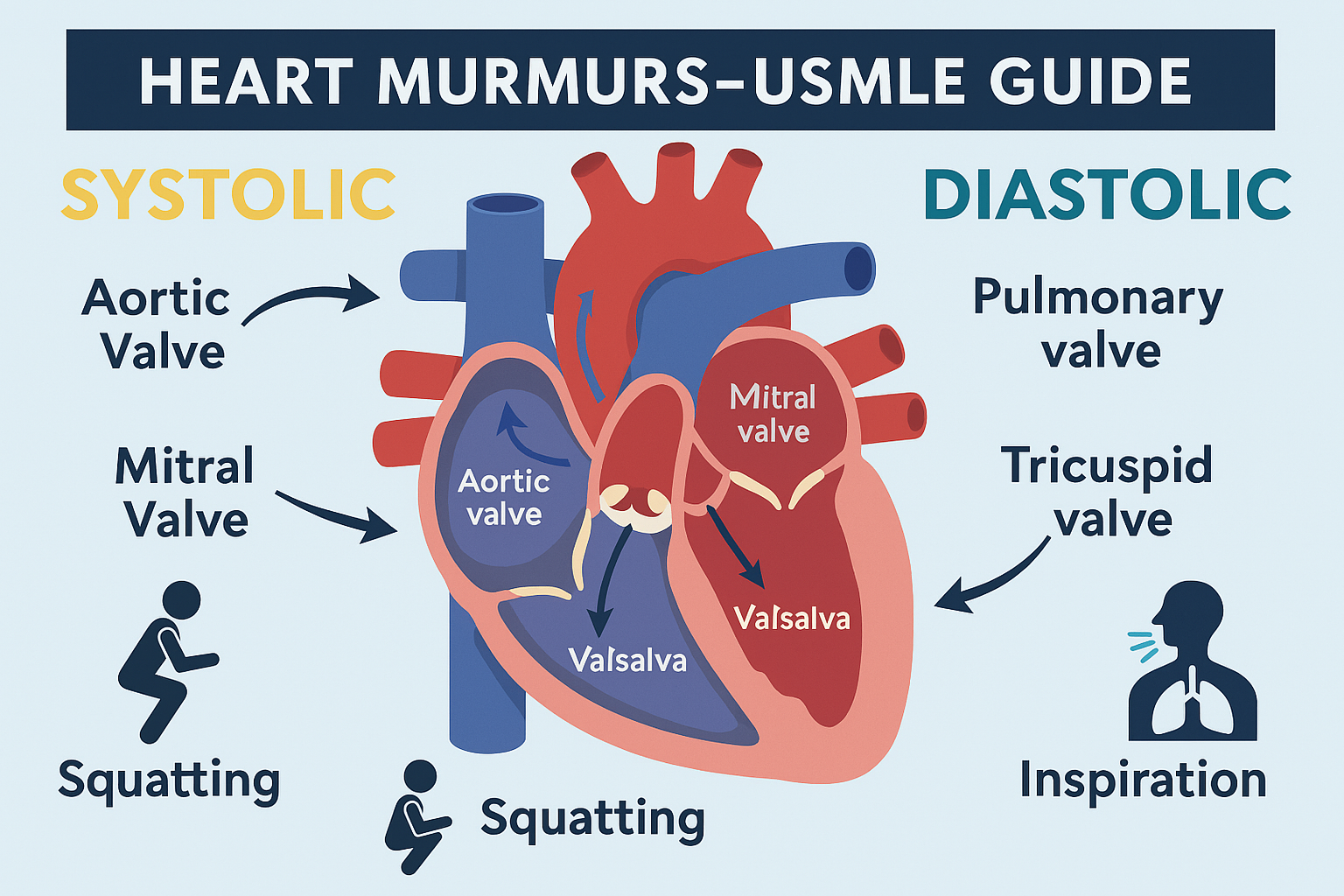Understanding Heart Murmurs – How to Master Auscultation for Step 1 & Step 2
Whether you’re learning them for the first time or reviewing before test day, heart murmurs are a must-know USMLE topic. From aortic stenosis to mitral regurgitation, questions will test not only your knowledge of the murmurs—but your ability to reason through timing, location, and maneuvers.
Systolic vs Diastolic: What You Must Know
| Murmur | Timing | Common Cause | Key Clue |
|---|---|---|---|
| Aortic Stenosis | Systolic | Aging, bicuspid aortic valve | Crescendo-decrescendo at R 2nd ICS |
| Mitral Regurgitation | Systolic | MVP, ischemia, rheumatic | Holosystolic at apex, radiates to axilla |
| Aortic Regurgitation | Diastolic | Aortic root dilation | Blowing decrescendo at LSB |
| Mitral Stenosis | Diastolic | Rheumatic fever | Opening snap + rumble at apex (LLDP) |
USMLE Tips: Maneuvers and Changes
Valsalva → decreases preload → murmurs like HOCM and MVP increase
Squatting → increases preload and afterload → decreases HOCM, increases MR
Inspiration → increases right-sided murmurs (e.g., tricuspid regurg)
Expiration → increases left-sided murmurs (e.g., mitral stenosis)
Step 1 & Step 2 Style Clues
A 70-year-old man presents with chest pain and syncope during exertion. Exam reveals a systolic murmur at the right upper sternal border. What’s the most likely diagnosis?
✅ Aortic Stenosis
Which maneuver increases this murmur’s intensity?
✅ Squatting
Mnemonics That Help
“MR. PASS wins the MVP”
MR, Pulmonic And Static Stenosis = Systolic
Mitral Valve Prolapse = also systolic
Everything else = diastolic
Common Distractors to Avoid
| Murmur Confusion | Key Differentiator |
|---|---|
| HOCM vs Aortic Stenosis | HOCM increases with Valsalva |
| Tricuspid Regurg vs Mitral Regurg | TR increases with inspiration |
| Mitral Stenosis vs Aortic Regurgitation | MS has opening snap; AR has bounding pulse |
Why KOTC Makes Cardio Easy
When you're trying to remember location, pitch, timing, and response to maneuvers, a well-placed visual or audio cue is game-changing. The King of the Curve app provides:
High-yield cardio visuals
Murmur quizzes with sound-based recall
Step 1–style clinical vignettes in timed mode
Explore more at 👉 kingofthecurve.org/studyscience
Call to Action
🔊 Don’t just memorize murmurs—hear them, visualize them, and master them with KOTC.
🎯 Join thousands of med students using KOTC to simplify high-yield cardio.
Start free now → kingofthecurve.org/free-lifetime
Frequently Asked Questions (FAQs)
-
Aim for 4-6 focused hours, ensuring you incorporate breaks to avoid burnout.
-
Practice mindfulness techniques, take practice exams under realistic conditions, and maintain a balanced lifestyle.
-
Set short-term goals, seek support from mentors, and reward yourself for small achievements.
-
Regular exercise improves focus, reduces stress, and enhances overall mental clarity.
-
KOTC offers personalized learning tools, gamification features, and adaptive question banks to help students stay on track without burnout.


